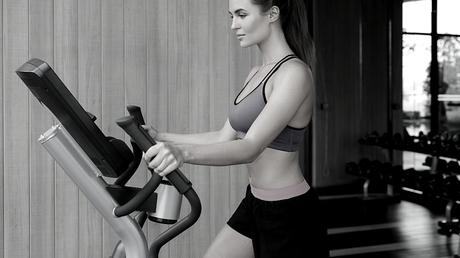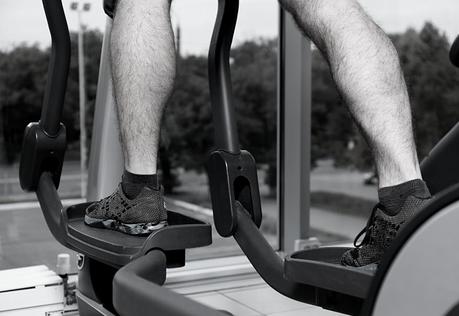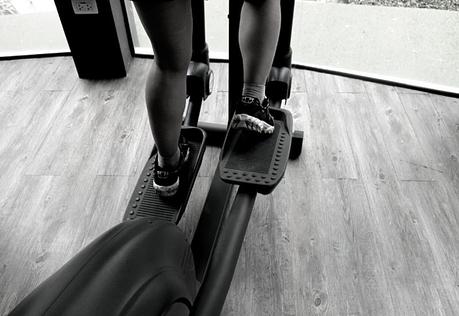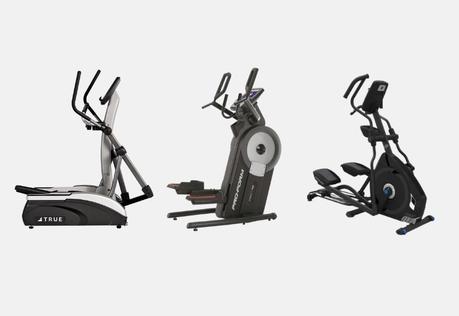Wondering how much elliptical machines weigh? Here’s a list of the weight of different ellipticals by brand and type, as well as the factors that influence how much elliptical trainers weigh.

Looking to install an elliptical machine in your home gym to take your cardio sessions to the next level?
Good for you!
Ellipticals are affordable, reliable, and versatile—everything you want in a piece of home gym equipment.
Typically, the two biggest factors people need to take into account when considering an elliptical for a home gym are:
- Cost. You’ve got to be able to afford it; hence the cost of an elliptical machine is an important consideration.
- Size. You’ve got to have enough space to fit it around your other equipment and furniture.
But thinking about the elliptical machine weight is another important consideration. After all, if it’s too heavy, it could damage your floors, or if it’s too light, it might slide around (when used by heavy trainees).
Elliptical machines weigh anywhere from 60 to 450lbs. Light commercial ellipticals, ideal for home use and regular use, tend to weigh in the 150 to 300lb range.
Below, we’ll take a deep dive into everything you need to know about how much an elliptical machine weighs, comparing the different weights by type, and looking at the factors that dictate their weight.
We’ll also compare a few of the more popular elliptical models so you can see just how much they weigh.
By the end of this post, you’ll have a much better idea of how much the average elliptical weighs, as well as the “ultra-light” and “ultra-heavy” models. It’ll make shopping for the right elliptical machine for your home gym a whole lot easier!
Let’s jump right in.
How Much Elliptical Machines Weigh (by Type)
As you know, there are a number of different types of elliptical machines to choose from (front drive, center drive, rear drive, cross trainer, compact, etc.).
Each of these machines has their own specific weight range, and understanding what that range is will help you to make the right choice for your home gym.

“Standard” Elliptical
When I talk about a “standard” elliptical machine, I’m referring to the front drive, center drive, and rear drive machines you see in most gyms and home gyms.
Typically, they feature a magnetic flywheel, pedals, handles, and a stand that supports the screen, controls, and electronics.
Typically, these come in two size ranges:
Lightweight – These are designed to be more compact, the “home-friendly” models.
They’re lighter and more movable, using a lighter flywheel, less complex internal motors and mechanisms, and with a lightweight frame and built-in caster wheels that let you move them around in your home gym.
Typically, they’ll weigh in the 60 to 140 pounds range. However, be aware that they may be too light for heavier users, or are built for shorter trainees with a shorter stride length.
Heavy-Duty – These are the sort of elliptical machines used by hardcore home trainees, or the sort you’d find equipped in your local gym.
They use a heavier flywheel (though not all), more complex internal motors and mechanisms (that facilitate incline and higher resistance levels), and a sturdier frame using heavy-duty materials that can withstand hours of use every day.
These will be on the heavier side—anywhere from 175 to 450 pounds—and once they’re installed, are not intended to be moved much.
Elliptical Cross Trainer/Lateral Elliptical
The elliptical cross trainer is a variation on the standard elliptical, one that allows you to change the handle position (for multiple upper body angles of muscle engagement).
The lateral elliptical, on the other hand, lets you adjust the movement of the pedals so you can focus on lateral (side to side) training as well as straight forward and back.
Typically, these machines are a bit heavier-duty because they require more internal mechanisms and motors to facilitate the different movement paths. You’ll find they end up being on the heavier side—usually in the 125 to 290 pound range.
Compact Elliptical
The compact elliptical is exactly as its name suggests: a compact elliptical machine, typically used under the desk or when sitting on the couch.
They’re not usually built to be used standing up, but you get your workout while sitting down (at a desk, chair, or on the couch) to maximize your activity time during a busy day.
Because of their compact design, they’re typically a lot lighter than the full-sized ellipticals.
You can find some as light as 20 pounds (easy to move around), though some can get as high as 100 pounds (for more heavy-duty options).
Elliptical Glider
The elliptical glider is a machine with no actual mechanisms! It utterly removes the flywheel and any electronic components from the equation, using your own bodyweight to provide the resistance. You simply stand on the pedals and use your arms and legs to “stride”.
The great thing about elliptical gliders is that they have no ultra-heavy internal components, so they’re usually on the lighter side. You can find some that weigh as little as 50 to 80 pounds. However, for a “heavy-duty” model built using sturdier metal for the frame, the weight can rise upwards of 100 pounds.
Why Elliptical Machines are so Heavy
There are a number of factors that contribute to the weight of an elliptical machine:

Flywheel
Most “standard” ellipticals, cross trainers, and lateral ellipticals use a metal flywheel with magnets that, when adjusted closer (using the “resistance” button), increase the difficulty of spinning the wheel with the pedals/handles, and thus gives you a better workout.
Really, it’s thanks to the flywheel that losing weight with an elliptical is possible and effective!
A flywheel alone can weigh anywhere from 14 to 35 pounds.
Typically, lighter-weight machines will use a light flywheel, because that’s all that’s needed to provide sufficient resistance for lighter trainees.
However, for bigger, heavier people, a heavier flywheel is needed (25 to 35 pounds) to provide sufficient resistance against their higher body weight.
Frame
The elliptical machine has to bear up under not just weight, but pressure and the repeated strain of rocking, shifting, and swinging with your movements. That means it needs to be built using a frame tough enough to withstand for years of regular use.
The weight of the frame will be largely determined by the metal used. Steel is the sturdiest choice, and will typically last longer, but some lightweight machines (elliptical gliders, for example) use aluminum, which is fractionally less sturdy but significantly lighter. Or parts of the frame will be built using metal, and some components made from aluminum.
The weight of the frame will be largely determined by the design, too.
For example, a center-drive elliptical doesn’t need a very large frame because the motor is set directly outside the pedals.
Compare that to a rear-drive elliptical, which needs long metal shafts to connect the motor to the pedals and handles, and you can see why their frames tend to be significantly heavier.
Heavy-duty ellipticals constructed for commercial gym use will also be significantly heavier than the sort of light-duty machines intended for home use.
Internal Mechanisms
Elliptical gliders are the only types of ellipticals without motors and internal mechanisms, which is why they’re incredibly lightweight. Other ellipticals—such as cross trainers, lateral ellipticals, and “standard” ellipticals—are all motor-powered and controlled by mechanisms.
For example, any elliptical that allows you to adjust the incline will require some sort of internal motors and mechanisms that raise the pedal height. Lateral cross-trainers will need similar mechanisms to accommodate a wider lateral stride.
Though the electronic components and screen tend to be fairly light, they also add to the weight of the machine.
Pedals and Handles
The pedals themselves may be made out of a sturdy plastic, but the shafts that connect them to the central motor and flywheel are typically steel.
The longer the stride length on the elliptical, the more metal is required to accommodate that stride length.
Rear drive machines typically have the longest shafts, which means the most amount of (heavy) metal used to connect the pedals to the internal resistance mechanisms.
The handles, too, will add a bit of weight. The handles are usually made out of aluminum or lightweight steel, but between the two of them, you’re still looking at an extra 10 to 15 pounds added onto the machine overall.
As you can see, there are a number of factors that contribute to the elliptical machine’s weight!
How Much Elliptical Machines Weigh (by Model)
As you saw above, the weight of the elliptical machine will vary from design to design, but even various models will come in a wide range of weights.

Below, I’ve put together a list of some of the more popular models from the best-known elliptical brands to give you an idea of how much each weighs:
ModelDesignWeight
Sunny Health E905Rear Drive Elliptical60 lbs.
Horizon EX-59Front Drive Elliptical145 lbs.
Bowflex Max Trainer M9Elliptical Cross Trainer150 lbs.
Schwinn 470Front Drive Elliptical164 lbs.
Nautilus E618Front Drive Elliptical210 lbs.
Life Fitness E1Rear Drive Elliptical212 lbs.
NordicTrack SpaceSaver SE7iRear Drive Elliptical215 lbs.
ProForm Pro HIIT H14Elliptical Cross-Trainer224 lbs.
Sole E95Front Drive Elliptical236 lbs.
NordicTrack Commercial 9.9Front Drive Elliptical244 lbs.
True Fitness PS300Center Drive Elliptical266 lbs.
Life Fitness Platinum Club SeriesRear Drive Elliptical459lbs.
The Bottom Line
There are a lot of elliptical trainer benefits that make it one of the best cardio machines to use in your home gym to take your training to the next level.
However, factoring in space, weight, and cost considerations is important when shopping for elliptical machines.
Based on the information above, you can see the difference in the various types of ellipticals, as well as the factors that determine each machine’s weight.
You should have enough information to make a smart choice of machine to use in your home, depending on what type of training you plan to do, how much resistance you need, whether you want a complex or simple elliptical, and how heavy-duty (sturdy) you want it to be.
At the end of the day, what matters most is that the machine works for your specific needs—whether that means a lightweight, movable machine or a heavy-duty machine capable of handling a higher weight capacity is entirely up to you.
More Elliptical Guides and Articles Like This
Life Fitness Elliptical Comparison – Which is Best for You? Looking to pick up a Life Fitness elliptical for your home gym? Here’s a detailed comparison of all of Life Fitness’s elliptical trainers, including pros and cons, so that you can decide with confidence.
Elliptical Buying Guide – Everything You Need to Know to Buy with Confidence. Want to buy an elliptical but don’t know where to start? Arm yourself with the knowledge to choose the perfect elliptical for you and your workout goals.
The Different Types of Elliptical Machines (Pros and Cons of Each). The elliptical machine is one of the best tools to achieve weight loss goals. Here’s a look at each type of elliptical machine, including the pros and cons of each, so that you can use the right one for you and your training goals.
